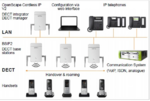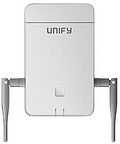Difference between revisions of "OpenScape Cordless IP V2"
The Wiki of Unify contains information on clients and devices, communications systems and unified communications. - Unify GmbH & Co. KG is a Trademark Licensee of Siemens AG.
| Line 31: | Line 31: | ||
This section gives you an overview over the most important features of OpenScape Cordless IP V2. | This section gives you an overview over the most important features of OpenScape Cordless IP V2. | ||
| + | |||
| + | |||
| + | === DECT IP base station (BSIP2) === | ||
| + | [[Image:BSIP2 picture.jpg|right|120px]] | ||
| + | |||
| + | DECT IP base stations form a network of radio cells and conduct communications with the handsets. If these radio cells overlap and are synchronized, the DECT handsets can move between the radio cells with an existing voice connection. | ||
| + | The best location for the DECT IP base stations for radio coverage in a building or site is determined by means of radio measurement. Special antennae can be used for increased radio ranges. The DECT IP base stations can be fitted with an outdoor casing to protect against inclement weather. | ||
| + | DECT IP base stations have the complete software for DECT and IP functionality. This software does not need to be configured and administered locally on the DECT IP base stations; this can be conveniently implemented on a centralized basis by means of the OpenScape Cordless IP V2 software. | ||
| + | |||
| + | |||
| + | |||
== Documentation and Training == | == Documentation and Training == | ||
Revision as of 09:54, 7 December 2017
OpenScape Cordless IP V2 is the DECT over IP solution for pure and hybrid Unify IP platforms.
The radio technology used in the OpenScape Cordless IP V2 solution complies with the DECT (Digital Enhanced Cordless Telecommunications) standard. The OpenScape Cordless IP V2 solution makes the DECT standard already established for mobile voice communications also available in Voice over IP infrastructures. The entire radio range managed by the system consists of DECT IP base stations that either together form a seamless network of overlapping and synchronous radio cells or individual islands of radio signals. The size of a radio cell depends on local conditions. The connection to the Voice over IP infrastructure is made by means of the SIP protocol. This means that DECT radio cells are the perfect way to supplement SIP-capable Voice over IP systems as mobile communication solutions. DECT IP base stations support the seamless handover of existing voice connections, in other words the changeover between the radio cell and a DECT handset during a call. In addition, the roaming function is made available to mobile users, i.e. the change of radio system without an existing call.
Contents
Key Features
The entire radio range managed by the system consists of DECT IP base stations that either together form a seamless network of overlapping and synchronous radio cells or individual islands of radio signals. The size of a radio cell depends on local conditions.
DECT IP base stations support the seamless handover of existing voice connections, in other words the changeover between the radio cell and a DECT handset during a call. In addition, the roaming function is made available to mobile users, i.e. the change of radio system without an existing call.
Solution Components
The OpenScape Cordless IP V2 system solution consists of the following main components:
- Handset: DECT handsets with PN-CAP functionality
- Base station: DECT IP base station with PN-CAP/GAP functionality for the DECT handsets and IP interface with the Ethernet network
- OpenScape Cordless IP V2 software (DECT Manager and Integrator) is the central software component for:
- controlling the DECT IP base stations
- implementing the SIP/RTP interfaces in the direction of the Communication Server
- central administration and configuration of the entire OpenScape Cordless IP V2 solution
The DECT Manager SW can run either on an active DECT IP base station (small solution) or on a DECT IP base station with deactivated DECT part (medium Solution).
The Integrator SW runs either together with the DECT Manager on a base station (small and medium solution) or separate on a virtual server (large solution)
Overview
This section gives you an overview over the most important features of OpenScape Cordless IP V2.
DECT IP base station (BSIP2)
DECT IP base stations form a network of radio cells and conduct communications with the handsets. If these radio cells overlap and are synchronized, the DECT handsets can move between the radio cells with an existing voice connection. The best location for the DECT IP base stations for radio coverage in a building or site is determined by means of radio measurement. Special antennae can be used for increased radio ranges. The DECT IP base stations can be fitted with an outdoor casing to protect against inclement weather. DECT IP base stations have the complete software for DECT and IP functionality. This software does not need to be configured and administered locally on the DECT IP base stations; this can be conveniently implemented on a centralized basis by means of the OpenScape Cordless IP V2 software.
Documentation and Training
End User License Agreement EULA






